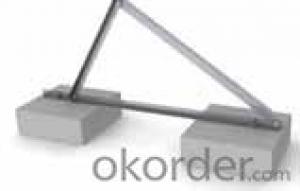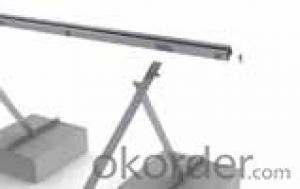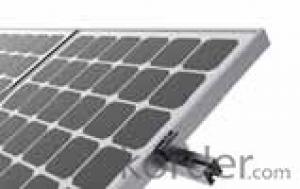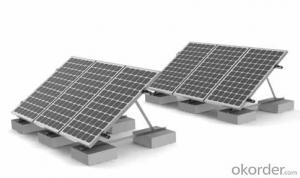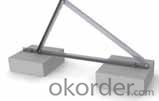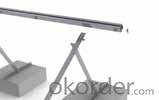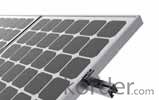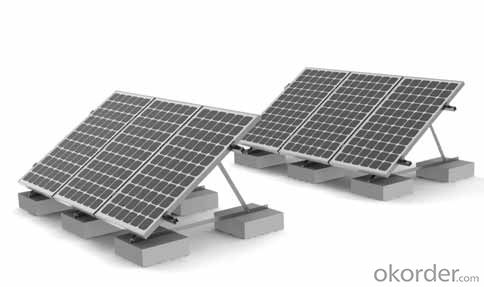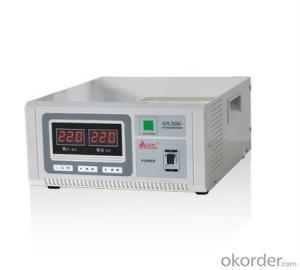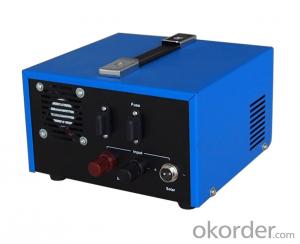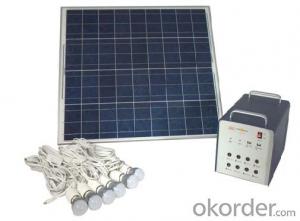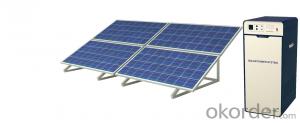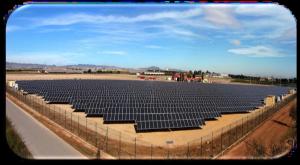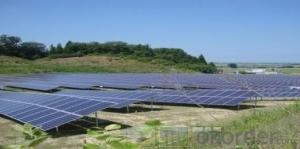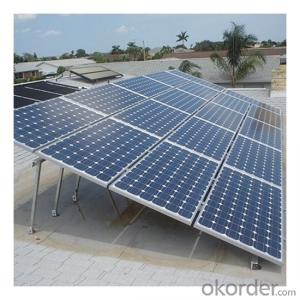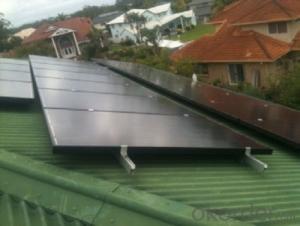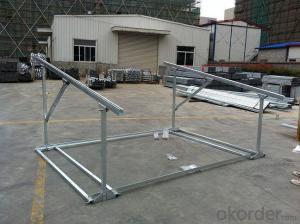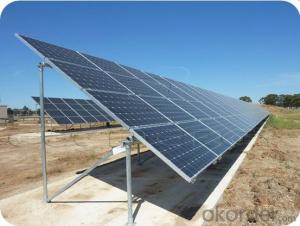Residential Solar Energy Flat Roof System Mounting
- Loading Port:
- China Main Port
- Payment Terms:
- TT OR LC
- Min Order Qty:
- -
- Supply Capability:
- -
OKorder Service Pledge
OKorder Financial Service
You Might Also Like
Product Features
• Adoptable to all kinds of crystalline modules and certain thin film modules.
• Direct foundation bolt , concrete base or bear load are the possible solution for ground installation.
• System installation inclination is adjustable according to requirement.
• Easy installation, only three kinds of tools could finish the installation.
1 Fix the triangular supporting frames
on the concrete base.
2 Fix the rail on the triangular
supporting frames with T-head bolt
and flange nut.
3 Locate the module clamps and put
the PV modules on the rail. Then just
need to fasten the bolt in the clamp.
Flat Roof System
Versolsolar system are being widely used
in all kinds of flat roof according to the
roof bearing capacity and waterproof
requirements. Usually we adopt load
way or chemical anchor bolt to fix the
system on the roof.
Versolsolar chooses high quality material
and good appearance, original design of
connection between al-rail and module
made the installation rapid. No second
processing to the components are
needed on site.
Insrallation site Flat roof
Module specification Frame / frameless module, silicon / film module
Installation inclination Client requirement
Module arrangement Portrait
Module area square Client arrangement
Module area position Client arrangement
Base frame AL 6063T5 / stainless steel
Small pieces Stainless steel, Al6063 T5
- Q: Can solar energy systems be used in areas with high rainfall?
- Yes, solar energy systems can be used in areas with high rainfall. While excessive cloud cover and rain may reduce the efficiency of solar panels, they can still generate electricity even in such conditions. In fact, some solar panels are designed to work optimally in diffused light, making them suitable for areas with frequent rainfall. Additionally, advancements in solar technology and battery storage systems have made it possible to store excess energy during sunny periods for use during rainy days, ensuring a continuous power supply.
- Q: Can solar energy systems be used for powering remote cabins or cottages?
- Certainly, solar energy systems have the ability to effectively power cabins or cottages in remote areas. In fact, solar power is an optimal option for locations that are not connected to the utility grid, as it offers a sustainable and dependable source of electricity. Solar energy systems consist of solar panels that convert sunlight into electricity, a charge controller to regulate battery charging, and an inverter to convert stored energy into usable AC power. This setup enables the panels to capture sunlight during the day and store excess energy in batteries for use during the night or on cloudy days. Remote cabins or cottages often lack access to conventional power sources, making solar energy systems an ideal solution. These systems can be custom-designed to meet the specific energy requirements of the cabin, taking into consideration the number of appliances, lights, and other electrical devices used. By appropriately sizing the solar panels and batteries, it is possible to provide sufficient power to meet the occupants' needs. Furthermore, solar energy systems require minimal maintenance and can endure for several decades with proper care. This makes them a cost-effective and dependable power source for remote cabins or cottages, eliminating the need for noisy and polluting diesel generators or the inconvenience of transporting fuel to the remote location. Additionally, solar energy systems can be combined with other renewable energy sources like wind turbines or micro-hydro systems to create hybrid power systems, ensuring a continuous power supply even during periods of limited sunlight. To sum up, solar energy systems are an outstanding choice for powering remote cabins or cottages. They offer a sustainable, reliable, and low-maintenance source of electricity, allowing occupants to enjoy the comforts of modern living even in remote locations.
- Q: How does the installation process of a solar energy system work?
- The installation process of a solar energy system typically involves several steps. Firstly, a site assessment is conducted to determine the suitability of the location for solar panels. Then, the necessary permits and paperwork are obtained. Next, the installation team mounts the solar panels on the roof or ground, ensuring proper alignment and positioning for optimal sunlight exposure. The panels are then connected to an inverter, which converts the captured solar energy into usable electricity. Finally, the system is tested, and if everything is functioning correctly, it is connected to the electrical grid or battery storage, enabling the homeowner to start generating clean, renewable energy.
- Q: How do solar energy systems handle excess energy production?
- Solar energy systems handle excess energy production through a process called net metering. When the solar panels produce more electricity than needed, the excess energy is fed back into the grid, and the solar system owner receives credits for the surplus electricity. These credits can then be used to offset the electricity consumed from the grid during periods of low solar energy production, such as at night or during cloudy days.
- Q: Are there any noise or sound issues with solar energy systems?
- Solar energy systems do not produce any noise or sound issues as they operate silently.
- Q: What is the difference between a solar energy system and a solar thermal system?
- A solar energy system and a solar thermal system both harness energy from the sun, but they differ in terms of how they convert and utilize that energy. A solar energy system, also known as photovoltaic (PV) system, uses solar panels made up of photovoltaic cells to directly convert sunlight into electricity. These solar panels contain semiconductor materials that create an electric current when exposed to sunlight. The electricity generated by the PV system can be used to power various electrical devices, such as lights, appliances, and even an entire house or building. It can also be stored in batteries for later use or fed back into the grid. On the other hand, a solar thermal system primarily focuses on utilizing the sun's energy to heat water or air. This system typically consists of solar collectors, which absorb sunlight and convert it into heat energy. The collected heat is then transferred to a fluid (usually water or anti-freeze) that circulates through the system. In a water-based solar thermal system, the heated fluid can be used directly for domestic hot water or space heating purposes. In contrast, an air-based solar thermal system uses the heated air to warm up indoor spaces. In summary, the main difference between a solar energy system and a solar thermal system lies in how they convert and utilize solar energy. A solar energy system converts sunlight directly into electricity, while a solar thermal system converts sunlight into heat energy for heating water or air.
- Q: Can solar panels be installed on canopies or awnings?
- Yes, solar panels can be installed on canopies or awnings. In fact, many businesses and homeowners choose to install solar panels on their canopies or awnings as it allows for dual functionality, providing shade and generating clean energy simultaneously. This installation method is particularly beneficial for places with limited roof space or those wanting to maximize their solar energy production.
- Q: Are there any maintenance costs associated with solar energy systems?
- Yes, there are maintenance costs associated with solar energy systems. While solar panels require very little maintenance compared to other energy systems, there are still some costs involved. These costs include regular cleaning of the panels to ensure maximum efficiency, inspection and repair of any damaged or malfunctioning components, and periodic replacement of parts that may wear out over time. Additionally, solar energy systems may require monitoring and maintenance of the batteries or inverters that store and convert the energy. It is also recommended to have a professional conduct an annual inspection to ensure the system is functioning properly. While these maintenance costs are typically low compared to the savings generated by solar energy, it is important to factor them into the overall cost analysis when considering the installation of a solar energy system.
- Q: Can solar energy systems be used for drying agricultural produce?
- Yes, solar energy systems can be used for drying agricultural produce. Solar dryers harness the power of the sun to dry crops and other agricultural products, reducing moisture content and preserving their quality. These systems provide a sustainable and cost-effective alternative to traditional drying methods, allowing farmers to extend the shelf life of their produce and reduce post-harvest losses.
- Q: What is the impact of lightning on the performance of solar panels?
- The performance of solar panels can be significantly affected by lightning, although it is relatively uncommon. When lightning strikes, it can cause physical damage to the solar panels, such as breaking the glass or causing harm to the wiring. Consequently, this damage can result in a decrease or even a complete loss of power generation from the affected panel. Furthermore, lightning can also create electrical surges that may harm the inverter, which is a vital component responsible for converting the direct current (DC) electricity produced by the panels into alternating current (AC) electricity for usage in homes or businesses. If the inverter is harmed, it can lead to a complete shutdown of the solar panel system until necessary repairs or replacements are carried out. To reduce the impact of lightning on solar panels, there are various protective measures that can be taken. One common approach is to install a lightning protection system that includes lightning rods or conductive pathways to safely direct the electrical discharge into the ground. This method helps to prevent lightning strikes from directly hitting the solar panels, thus reducing the risk of damage. Additionally, surge protectors can be installed to safeguard the inverter and other sensitive electronic components of the solar panel system. These surge protectors work by redirecting excessive electrical energy from lightning strikes away from the system, thereby safeguarding it from potential harm. Although lightning strikes can pose a threat to the performance of solar panels, it is important to note that modern solar panel systems are generally designed to withstand severe weather conditions, including lightning. Manufacturers often subject their panels to rigorous testing to ensure their durability and resistance to lightning strikes. Overall, while the impact of lightning on solar panels can be disruptive and expensive, implementing appropriate protective measures can help minimize the risk and ensure the long-term performance and reliability of the solar panel system.
Send your message to us
Residential Solar Energy Flat Roof System Mounting
- Loading Port:
- China Main Port
- Payment Terms:
- TT OR LC
- Min Order Qty:
- -
- Supply Capability:
- -
OKorder Service Pledge
OKorder Financial Service
Similar products
Hot products
Hot Searches
Related keywords
